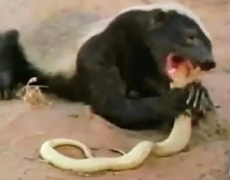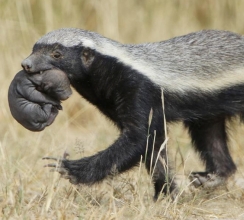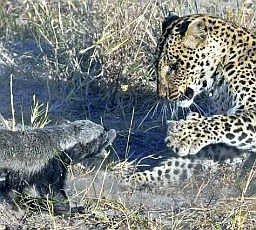 The Honey Badger, or ratel, is a small mammal that is very strong and tough. It's a member of the weasel family, which includes skunks. The scientific name of the honey badger is Mellivora capensis. Honey badgers are found in bushy areas of Africa and southern Asia. They live in holes which they dig with their strong front legs. Adult honey badgers are about 30 centimetres tall at the shoulder, and up to 75 cm long, with tails about 30 centimetres. Honey badgers are heavily built, with thick skins. They are incredibly fierce predators.  Honey badgers are nocturnal, mostly active at night. Their prey includes scorpions, termites, and worms. They will also eat larger prey, such as porcupines, rabbits, turtles, and snakes. Honey badgers are nocturnal, mostly active at night. Their prey includes scorpions, termites, and worms. They will also eat larger prey, such as porcupines, rabbits, turtles, and snakes. Honey badgers will pull apart bee hives and consume not only the honey, but the bee larvae as well. The honey badger's skin is so thick that it can withstand bee stings, porcupine quills, and even dog bites. They also seem to be resistant to snake venom. The honey badger has a gland at the base of its tail that stores a noxious liquid. It uses this to mark its territory, but if it's frightened or threatened, it will deposit some on the ground, rather than spraying it like its skunk relative does. The odour doesn't last long, but it leaves a clear message to predators.  Known for its fearless nature and tenacity, this small mammal has earned a reputation as one of nature’s most formidable predators.
Despite its small stature, the honey badger will take on adversaries many times its own size, facing off against lions, hyenas, and venomous snakes. Known for its fearless nature and tenacity, this small mammal has earned a reputation as one of nature’s most formidable predators.
Despite its small stature, the honey badger will take on adversaries many times its own size, facing off against lions, hyenas, and venomous snakes. Its skin is tough and loose, allowing it to twist around and bite an opponent that has grabbed it by the back of its neck. It has a massive skull, strong jaw, and sharp teeth capable of crushing tough shells and bones, allowing it to prey on tortoises, porcupines, and other creatures. Honey badgers are good swimmers and can climb trees. They are also very intelligent. They have been observed using tools to extract food from hard-to-reach places, such as using sticks to dig out beetle larvae from tree bark.  The female honey badger is left alone to give birth and raise her young. She digs a chamber and lines it with grass. After 10 weeks, one cub is born. The 20 gram newborn is hairless, with pink skin and closed eyes. At a week of age, its skin begins to change from pink to gray; soon, fine gray hair begins to grow, and the familiar white stripe appears.
The female honey badger is left alone to give birth and raise her young. She digs a chamber and lines it with grass. After 10 weeks, one cub is born. The 20 gram newborn is hairless, with pink skin and closed eyes. At a week of age, its skin begins to change from pink to gray; soon, fine gray hair begins to grow, and the familiar white stripe appears. By the time the cub is close to three months old, it has become a perfect miniature of its parents. It reaches adult size at 6 months, but is not ready to go off on its own until it's over a year old, needing time to develop hunting skills.    |